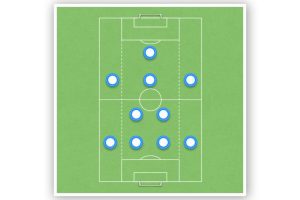Building Up from the Back in Soccer: A Comprehensive Guide to Starting Your Attack from the Defense
Building up from the back is a popular strategy in soccer that involves starting an attack from the goalkeeper and moving the ball forward through the defenders and midfielders. This approach helps teams maintain possession and control of the game, while also creating opportunities to score goals. While the tactic requires skill and coordination from all players involved, it can be an effective way to break down opponents and win matches.
One of the key advantages of building up from the back is that it allows teams to maintain possession of the ball and control the pace of the game. By starting the attack from the goalkeeper, players can move the ball forward in a controlled and deliberate manner, rather than simply launching it up the field and hoping for the best. This approach can help teams maintain pressure on their opponents and create scoring opportunities, while also minimizing the risk of losing possession.
To successfully build up from the back, teams need to have strong communication and coordination between their players. Defenders and midfielders need to be able to read each other’s movements and make quick, accurate passes to move the ball up the field. Additionally, the goalkeeper needs to be comfortable with the ball at their feet and able to make quick decisions under pressure. While building up from the back can be challenging, it can be a highly effective strategy for teams that are willing to put in the work to master it.
Building from the Back: Why It Matters
Building from the back is a strategy in soccer that involves starting the attack from the goalkeeper or the defenders. This approach has become increasingly popular in recent years, with many teams adopting it as a preferred method of play. In this section, we will explore why building from the back matters and the advantages it offers.
Advantages of Building from the Back
Possession
One of the primary advantages of building from the back is possession. By starting the attack from the goalkeeper or defenders, a team can maintain possession of the ball and keep the opposition under pressure. This approach allows the team to control the pace of the game and dictate the flow of play.
Space
Building from the back also creates space on the field. By starting the attack from deep, the defenders and midfielders can stretch the opposition and create gaps in their defensive structure. This approach provides the forwards with more space to operate in and can lead to more scoring opportunities.
Pressure
Building from the back puts pressure on the opposition. By playing short passes and maintaining possession, the team can force the opposition to press high up the field. This approach can create gaps in the opposition’s defense, providing the team with more space to attack.
Coaching Points
To successfully build from the back, there are several coaching points that teams must focus on. These include:
- Communication: Players must communicate effectively to ensure that each player knows their role and responsibilities.
- Movement: Players must move into space to create passing options for the player on the ball.
- Technical Ability: Players must have good technical ability to maintain possession and play accurate passes.
- Decision Making: Players must make quick and accurate decisions to keep the play moving and avoid turnovers.
Building from the back is an effective strategy that offers several advantages to teams. By maintaining possession, creating space, and putting pressure on the opposition, teams can control the pace of the game and create more scoring opportunities. However, to successfully implement this strategy, teams must focus on key coaching points such as communication, movement, technical ability, and decision making.
The Role of the Goalkeeper
The goalkeeper is a crucial player in the team’s strategy for building up from the back in soccer. This player is responsible for initiating the play and distributing the ball to the rest of the team. The goalkeeper must be comfortable with the ball at their feet and able to make quick decisions under pressure.
Goal Kicks
One of the ways in which the goalkeeper can start the play is through a goal kick. A goal kick is awarded to the defending team when the ball goes out of bounds over the end line, and it was last touched by an attacking player. The goalkeeper takes the goal kick from within their own penalty area.
When taking a goal kick, the goalkeeper has several options. They can kick the ball long towards the midfield or the attacking third, or they can play a short pass to a teammate. The choice of the option will depend on the team’s strategy and the opposition’s tactics.
If the goalkeeper decides to play a short pass, they must be aware of the opposing team’s pressing and positioning. They should look for a teammate who is in a good position to receive the ball and start the play. The goalkeeper must also communicate clearly with their teammates, letting them know where they want the ball to go.
So, the goalkeeper plays a vital role in building up from the back in soccer. They must be comfortable with the ball at their feet and able to make quick decisions under pressure. When taking a goal kick, the goalkeeper has several options, and they must choose the best one based on the team’s strategy and the opposition’s tactics.
The Centre-Backs’ Role in Building Up
The centre-backs play a crucial role in building up play from the back in soccer. They are responsible for starting the attack by playing accurate passes to their teammates, while also protecting the team’s goal. In this section, we will discuss the different aspects of the centre-backs’ role in building up play.
Playing Out from the Back
One of the most important tasks of the centre-backs is to play out from the back. This involves receiving the ball from the goalkeeper and distributing it to their teammates. When playing out from the back, the centre-backs need to be calm, composed, and confident on the ball. They must also be able to read the game and make quick decisions.
To play out from the back successfully, the centre-backs must be able to find space and create passing angles. This requires good positioning and awareness of their surroundings. They must also be able to communicate effectively with their teammates to ensure that everyone is on the same page.
Compact Play
Another key aspect of the centre-backs’ role in building up play is compact play. This involves maintaining a compact shape when in possession of the ball. By staying close together, the team can create passing options and move the ball up the field more effectively.
The centre-backs must be able to recognize when the team needs to play compact and adjust their positioning accordingly. They must also be able to move the ball quickly and accurately to prevent the opposition from closing down space.
To achieve compact play, the centre-backs must also be able to read the game and anticipate the opposition’s movements. This requires good tactical awareness and the ability to make quick decisions.
The centre-backs play a crucial role in building up play from the back in soccer. They must be able to play out from the back and maintain compact play to ensure that the team can move the ball up the field effectively. By doing so, they can help to create scoring opportunities and control the game.
The Importance of Fullbacks in Building Up
Fullbacks play a crucial role in building up from the back in soccer. They are defenders that play on the right or left side of the backline and are responsible for defending the wide areas of the field. But in addition to their defensive duties, fullbacks also offer attacking support to the wingers and midfielders, making them an essential part of a team’s attacking strategy.
Overlapping Runs
One of the key ways that fullbacks contribute to building up from the back is through overlapping runs. This is when a fullback runs past a winger or midfielder who has the ball, creating an overlapping option for them to pass to. This not only gives the attacking player more options, but it also stretches the opposition’s defense, creating more space for the attacking team to exploit.
When a fullback makes an overlapping run, they need to time their run correctly so that they don’t get in the way of the attacking player with the ball. They also need to be aware of the opposition’s positioning so that they can make a well-timed run that catches the defense off guard.
Fullbacks also need to have good technical skills to be effective in making overlapping runs. They need to be able to control the ball well, pass accurately, and cross the ball into the box when necessary.
Basically, fullbacks play a crucial role in building up from the back in soccer. Their overlapping runs provide an attacking option for the team while also stretching the opposition’s defense. Fullbacks need to time their runs correctly, be aware of the opposition’s positioning, and have good technical skills to be effective in making overlapping runs.
The Role of Midfielders in Building Up
In soccer, midfielders play a crucial role in building up from the back. They are responsible for receiving the ball from the defenders and distributing it effectively to the forwards. This section will discuss the roles of central midfielders and attacking midfielders in building up from the back.
Central Midfielder
Central midfielders are the backbone of the team. They are responsible for controlling the tempo of the game and maintaining possession. They play a critical role in building up from the back by providing passing options for the defenders and initiating attacks.
Central midfielders must have excellent positional awareness and be able to read the game well. They must also have good passing skills and be able to distribute the ball accurately and quickly. In addition, they must be able to defend well and provide cover for the defenders.
Attacking Midfielder
Attacking midfielders are responsible for creating goal-scoring opportunities. They play a critical role in building up from the back by providing the forwards with quality passes and making penetrating runs into the opposition’s half.
Attacking midfielders must have excellent technical skills and be able to dribble past defenders. They must also have good passing skills and be able to provide accurate crosses and through balls. In addition, they must be able to score goals themselves and have a good understanding of the game.
The Attackers’ Role in Building Up
In the modern game of soccer, attackers play a crucial role in building up from the back. They are responsible for creating space and opportunities to receive the ball and progress it up the field. In order to effectively build up from the back, attackers must be able to play forward and make intelligent runs.
Playing Forward
Playing forward is a key aspect of building up from the back. Attackers must be willing to receive the ball in tight spaces and quickly move it forward to their teammates. This requires excellent ball control, vision, and decision-making skills.
One effective way for attackers to play forward is by making diagonal runs towards the opposition’s goal. This creates space for their teammates to pass into and allows them to receive the ball facing forward. Attackers can also make runs into the channels between the opposition’s defenders, which can create overloads and scoring opportunities.
Another important aspect of playing forward is knowing when to take risks. Attackers must be willing to take on defenders and attempt difficult passes in order to break down the opposition’s defense. However, they must also be aware of when to play safe and keep possession of the ball.
Building Up Against a Pressing Team
When facing a pressing team, building up from the back can be challenging. However, with the right coaching points and strategies, a team can successfully navigate through the press and create scoring opportunities.
Coaching Points
To effectively build up against a pressing team, coaches should focus on the following coaching points:
- Maintain possession: The key to building up against a pressing team is to maintain possession of the ball. The team should focus on short, quick passes to move the ball up the field.
- Create passing options: To maintain possession, the team needs to create passing options. This means players need to move into space to receive the ball and provide options for their teammates.
- Use the width of the field: When facing a pressing team, it’s important to use the full width of the field. This will stretch the opposition and create more space for the team to move the ball.
- Be patient: Building up against a pressing team can take time. It’s important for the team to be patient and not force passes that aren’t there.
- Switch the play: Switching the play can be an effective way to break down a pressing team. This means quickly moving the ball from one side of the field to the other to create space and opportunities.
- Exploit the space behind the press: When a team presses, they leave space behind them. Coaches should encourage their players to look for opportunities to exploit this space with through balls or quick counter-attacks.
Pressure
When facing a pressing team, it’s important to understand the different types of pressure that can be applied.
- High pressure: High pressure is when the opposition tries to win the ball back in the attacking third of the field. This can be difficult to play against but can also leave space behind the press.
- Midfield pressure: Midfield pressure is when the opposition tries to win the ball back in the midfield. This can be easier to play against but can also limit passing options.
- Low pressure: Low pressure is when the opposition drops back and defends in their own half. This can allow the team to maintain possession but can also limit attacking opportunities.
Understanding the type of pressure being applied can help coaches develop the right strategies to build up from the back.
Building up from the back against a pressing team requires patience, quick passing, and an understanding of the different types of pressure. By focusing on the right coaching points and strategies, a team can successfully navigate through the press and create scoring opportunities.
Building Up Against a Defending Team
When building up from the back against a defending team, it is important to be patient and focus on maintaining possession. The defending team will often try to press high and force mistakes, so it is crucial to have a clear plan in place and execute it effectively.
Small-Sided Game
One effective way to practice building up against a defending team is through small-sided games. In this type of game, the focus is on maintaining possession and moving the ball up the field in a controlled manner.
To set up a small-sided game, mark out a 60 x 50 yard area using cones and split the pitch into four zones: 10 yards at each end and two 20-yard zones in the middle. Play 8v8 plus a manned goal. Tackling is not allowed inside a 10-yard zone if that team is launching an attack. This allows a defender to build an attack unopposed through the central “play zones” to get into the attacking third.
In this game, the defending team (blue) should work to make the field small and look for gaps in between the lines. Every player (except goalkeeper) should have a backwards, forwards, and sideways option to play at all times. This will allow the team to maintain possession and move the ball up the field in a controlled manner.
Overall, building up from the back against a defending team requires patience, focus, and a clear plan. By using small-sided games to practice these skills, teams can improve their ability to maintain possession and move the ball up the field effectively.
Conclusion
Building up from the back is a strategy that requires patience, skill, and teamwork. It can be a highly effective way to control the game and create scoring opportunities. By keeping possession through your goalkeeper, back line and midfielders, you can make the field as wide as possible and move up the pitch as a unit.
Coaches can use session plans and videos to teach their players how to implement this strategy effectively. They can also focus on specific positions, such as full-backs and centre-backs, to ensure that their team is building out of the back in a safe and efficient manner.
While building up from the back can be risky, it can also be rewarding. Playing forwards and maintaining a solid defensive shape are key components of this strategy. Attacking teams can exploit this strategy by pressing and counter-pressing effectively.
In conclusion, building up from the back is a valuable tool in a soccer team’s arsenal. With the right coaching and execution, it can lead to success on the field.








